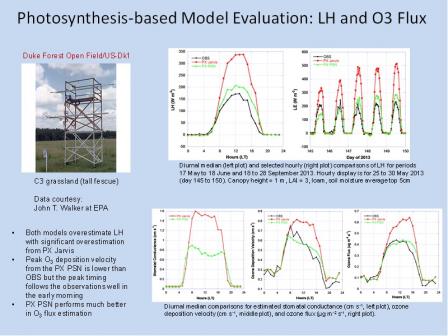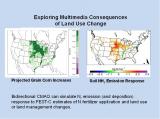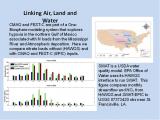Research Highlights Archive
EPA scientists have primary responsibility for the continual development of CMAQ and its related models. There are currently a number of research projects underway that focus on a range of topics, from exploration of atmospheric science fundamentals to incorporation and evaluation of recent scientific breakthroughs into research versions of the CMAQ model. Eventually, this new knowledge will serve the public by being incorporated in future publicly available CMAQ releases. The research and development team welcome comments and questions about these topics and would be happy to discuss the potential for collaborations.
Research Highlights Archive: Table of Contents
- Impacts of particulate matter on boundary layer mixing
- Improving vegetation processes for WRF/CMAQ using MODIS vegetation (LAI and FPAR) product and a coupled photosynthesis and stomatal conductance approach
- Air-land-water integrated assessments using coupled FEST-C EPIC, WRF/CMAQ, and SWAT modeling systems
- Understanding pathways to organic aerosol
- Improving representation of sources and sinks of atmospheric particles
- Novel atmospheric chemistry pathways
- Heterogeneous chemistry on the surface of dust
Impacts of Particulate Matter on Boundary Layer Mixing
Researcher: Rohit Mathur
Posted: June 2017
Citations: Wang, J., Xing, J., Mathur, R., Pleim, J.E., Wang. S., Hogrefe, C., Gan, C.-M., Wong, D.C., and Hao, J. (2016) Historical Trends in PM2.5-Related Premature Mortality during 1990-2010 across the Northern Hemisphere. Environmental Health Perspectives. doi: 10.1289/EHP298. EXIT
Xing, J., Wang, J., Mathur, R., Pleim, J., Wang, S., Hogrefe. C., Gan, C.-M., Wong, D.C., and Hao, J. (2016). Unexpected Benefits of Reducing Aerosol Cooling Effects. Environ. Sci. Technol, 50(14), 7527–7534. doi: 10.1021/acs.est.6b00767. EXIT
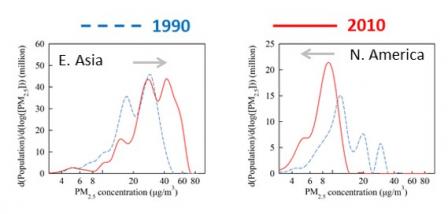 Contrasting trends in population exposure to ambient PM2.5: Control measures have significantly reduced exposure to high levels of PM2.5 in North America, but uncontrolled growth has resulted in larger populations being exposed to higher PM2.5 in many parts of Asia.Summary: Two journal articles on comprehensive modeling of 1990-2010 trends in air pollution exposure across the Northern Hemisphere demonstrate the benefits of EPA's fine particulate matter (PM2.5) control measures, including some that were unexpected. Modeling results in Wang et al. (2016) indicate that while PM2.5-related mortalities in East Asia and South Asia increased 21 percent and 85 percent, respectively, they decreased in Europe and North America substantially by 67 percent and 58 percent respectively. A companion article, Xing et al. (2016), shows that while fine particles contributed to cooling effects, partially offsetting greenhouse gas warming, because of reduced atmospheric mixing resulting from the cooling, air pollutants become more concentrated locally, especially in highly polluted and populated regions. Therefore, control measures aimed at reducing PM2.5 -related mortalities, result in unexpected additional benefits, making the controls even more effective than originally projected.
Contrasting trends in population exposure to ambient PM2.5: Control measures have significantly reduced exposure to high levels of PM2.5 in North America, but uncontrolled growth has resulted in larger populations being exposed to higher PM2.5 in many parts of Asia.Summary: Two journal articles on comprehensive modeling of 1990-2010 trends in air pollution exposure across the Northern Hemisphere demonstrate the benefits of EPA's fine particulate matter (PM2.5) control measures, including some that were unexpected. Modeling results in Wang et al. (2016) indicate that while PM2.5-related mortalities in East Asia and South Asia increased 21 percent and 85 percent, respectively, they decreased in Europe and North America substantially by 67 percent and 58 percent respectively. A companion article, Xing et al. (2016), shows that while fine particles contributed to cooling effects, partially offsetting greenhouse gas warming, because of reduced atmospheric mixing resulting from the cooling, air pollutants become more concentrated locally, especially in highly polluted and populated regions. Therefore, control measures aimed at reducing PM2.5 -related mortalities, result in unexpected additional benefits, making the controls even more effective than originally projected.
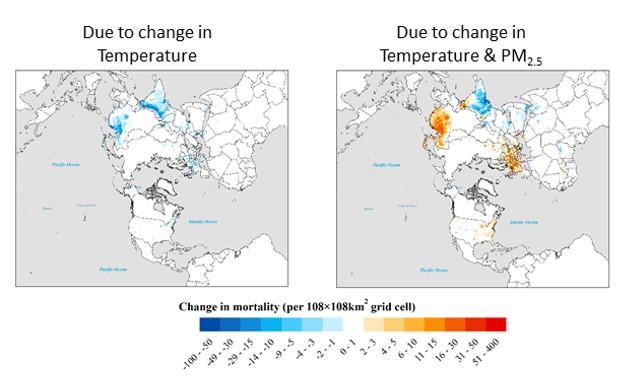 Mortality changes resulting from aerosol radiative effects on temperature (left) and combined temperature and PM2.5 (right).Top of Page
Mortality changes resulting from aerosol radiative effects on temperature (left) and combined temperature and PM2.5 (right).Top of Page
Improving Vegetation Processes for WRF/CMAQ Using MODIS Vegetation (LAI and FPAR) Product and a Coupled Photosynthesis and Stomatal Conductance Approach
Researcher: Limei Ran
Posted: June 2017
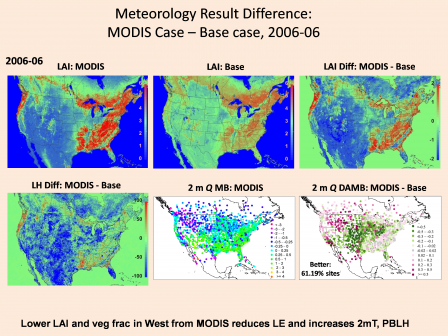 Citations: The following links exit the site ExitRan, L., Gilliam, R., Binkowski, F.S., Xiu, A., Pleim, J., & Band, L. (2015). Sensitivity of the WRF/CMAQ modeling system to MODIS LAI, FPAR, and albedo. J. Geophys. Res. Atmos., 120(16), 8491-8511. https://doi.org/10.1002/2015JD023424
Citations: The following links exit the site ExitRan, L., Gilliam, R., Binkowski, F.S., Xiu, A., Pleim, J., & Band, L. (2015). Sensitivity of the WRF/CMAQ modeling system to MODIS LAI, FPAR, and albedo. J. Geophys. Res. Atmos., 120(16), 8491-8511. https://doi.org/10.1002/2015JD023424
Ran, L., Pleim, J., Gilliam, R., Binkowski, F.S., Hogrefe, C., & Band, L. (2016a). Improved meteorology from an updated WRF/CMAQ modeling system with MODIS vegetation and albedo. J. Geophys. Res. Atmos., 121, 2393–2415. https://doi.org/10.1002/2015JD024406
Ran, L., Pleim, J., Song, C., Band, L., Walker, J.T., & Binkowski, F.S. (2016b). A Photosynthesis-based Two-leaf Canopy Stomatal Conductance Model for Meteorology and Air Quality Modeling with WRF/CMAQ PX LSM. J. Geophys. Res. Atmos. https://doi.org/10.1002/2016JD025583.
Summary: EPA scientists have been working on improving land surface processes in the Wweather Research and Forecasting (WRF)/CMAQ modeling system with a focus on vegetation. With realistic MODIS vegetation being evaluated and ingested into the system (Ran et al., 2015; Ran et al., 2016a) and a coupled photosynthesis and stomatal conductance approach being evaluated for the system (Ran et al., 2016b), scientists are implementing the photosynthesis-based approach into the system. Meanwhile, EPA researchers are developing new land cover categories with irrigation information and plant function types which are more suitable for the photosynthesis-based approach. The CMAQ team is also developing and evaluating a simple irrigation scheme in WRF for preparing to use the new land cover categories. Ultimately, the system with improved land surface representation and vegetation processes can be used to assess the coupling effects of air quality, climate, and vegetation productivity directly with CO2 concentration which changes temporally and spatially. For example, the system will have the ability to assess the effects of air pollutants such as O3 on ecosystem productivity in addition to CO2 influence.
Air-Land-Water Integrated Assessments Using Coupled FEST-C EPIC, WRF/CMAQ, and SWAT Modeling Systems
Researchers: Ellen Cooter and Limei Ran
Posted: June 2017
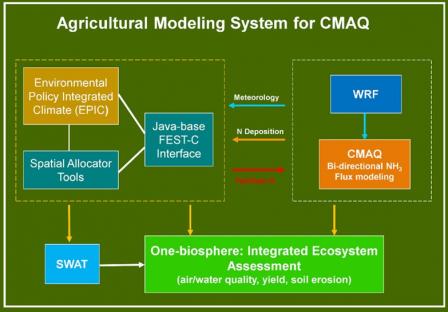 Schematic of modeling agricultural systems in CMAQ.EPA researchers are continuing efforts on improving and advancing an agriculture fertilization and production model (FEST-C EPIC) coupled with WRF/CMAQ and the Soil and Water Assessment Tool (SWAT) for air quality and ecosystem assessments. This coupling is required for bidirectional CMAQ simulations. Improving this coupling leads directly to improved CMAQ estimates of nitrogen (N) deposition and emissions (N removal) and particulate matter concentrations. Currently, the system is used to assess the impacts of agricultural fertilization and management practices on air quality (NH3) and climate (N2O), as well as the impacts of meteorology/climate and air quality (N deposition) on crop yield, soil erosion and water quality at regional scales. EPA scientists are improving the system on the crop and biomass production in comparison with USDA reports. As climate change is affecting agriculture, crop production under different climate and air quality, like O3
Schematic of modeling agricultural systems in CMAQ.EPA researchers are continuing efforts on improving and advancing an agriculture fertilization and production model (FEST-C EPIC) coupled with WRF/CMAQ and the Soil and Water Assessment Tool (SWAT) for air quality and ecosystem assessments. This coupling is required for bidirectional CMAQ simulations. Improving this coupling leads directly to improved CMAQ estimates of nitrogen (N) deposition and emissions (N removal) and particulate matter concentrations. Currently, the system is used to assess the impacts of agricultural fertilization and management practices on air quality (NH3) and climate (N2O), as well as the impacts of meteorology/climate and air quality (N deposition) on crop yield, soil erosion and water quality at regional scales. EPA scientists are improving the system on the crop and biomass production in comparison with USDA reports. As climate change is affecting agriculture, crop production under different climate and air quality, like O3![]() O3Ozone (O3) is a colorless gas with a pungent odor. It is found in two layers of the atmosphere, the stratosphere and the troposphere. In the stratosphere, ozone provides a protective layer shielding the Earth from ultraviolet radiation's potentially harmful health effects. At ground level (the troposphere), ozone is a pollutant that affects human health and the environment, and contributes to the formation of smog. damage, scenarios can be assessed using this system to address food security, risk mitigation, and policies with a holistic approach. The CMAQ team is assessing the impacts of climate on fertilization and productions and in turn on water quality through 11-year simulations using the integrated system. The system will be expanded to the globe for the next generation air quality modeling system at the global scale. Ongoing research focuses on other predicted FEST-C EPIC variables such as temporally resolved leaf area index for natural vegetation, like mixed forest, and dust emissions associated with agricultural tillage activities.
O3Ozone (O3) is a colorless gas with a pungent odor. It is found in two layers of the atmosphere, the stratosphere and the troposphere. In the stratosphere, ozone provides a protective layer shielding the Earth from ultraviolet radiation's potentially harmful health effects. At ground level (the troposphere), ozone is a pollutant that affects human health and the environment, and contributes to the formation of smog. damage, scenarios can be assessed using this system to address food security, risk mitigation, and policies with a holistic approach. The CMAQ team is assessing the impacts of climate on fertilization and productions and in turn on water quality through 11-year simulations using the integrated system. The system will be expanded to the globe for the next generation air quality modeling system at the global scale. Ongoing research focuses on other predicted FEST-C EPIC variables such as temporally resolved leaf area index for natural vegetation, like mixed forest, and dust emissions associated with agricultural tillage activities.
Understanding Pathways to Organic Aerosol
Researcher: Havala Pye
Posted: June 2017
For organic compounds of high solubility or low vapor pressure, the particle phase is an intermediate in their life cycle in the atmosphere. Due to thousands of compounds being present in organic aerosol, multiple approaches have been used to represent the formation of organic aerosol. Improvements in the representation of secondary organic aerosol as well as emitted organic aerosol are still needed to improve the CMAQ team’s confidence in how organic aerosol can be expected to respond to changes in emissions.
Improving Representation of Sources and Sinks of Atmospheric Particles
Researcher: Ben Murphy
Posted: June 2017
Particles are introduced to the atmosphere via both direct emissions (primary) and transformation of low-volatility vapors (secondary). In order to understand and quantify the importance of both of these pathways, we have enhanced the representation of the particle size distribution in CMAQ to treat four modes, Nucleation, Aitken, Accumulation and Coarse. We are currently investigating the incorporation of state-of-the-art parameterizatoins for new particle formation from sulfuric acid, ammonia, amines, and organic compounds. Meanwhile, we are also investigating the effect of representing particle direct emissions with source-specific size distributions from, for example, automobiles, fires and power plants.
Studies show that partitioning of organic compounds is important for combustion sources of primary particulate matter to the atmosphere. Example combustion sources include vehicles, power generation, residential wood burning, prescribed and wild fires, construction equipment, and yard appliances among others. New parameterizations exist for modeling the volatility distribution of these compounds. However, there is a potential disconnect between the experimental conditions at which these parameterizations were developed and the conditions at which emission factors were obtained for input to the National Emissions Inventory and SPECIATE databases, which are used to inform anthropogenic emissions in models. Current efforts will determine how to adjust available speciation profiles to ensure consistency among these data sources and provide photochemical models with accurate combustion emissions.
Understanding the removal processes of atmospheric pollutants is many times just as important as understanding their sources. Thus, we are currently improving the ability CMAQ to represent both in-cloud and below-cloud scavenging of particles at local and regional scales. When employed, these improvements to the particle representation will allow CMAQ to predict particle size distributions with enhanced accuracy and lend confidence to applications that use CMAQ data to interpret human health impacts of pollution, for example.
Novel Atmospheric Chemistry Pathways
Researcher: Golam Sarwar
Posted: June 2017
Iodine and Bromine Chemistry
Iodine and bromine, emitted from seawater, can participate in atmospheric chemistry and affect air quality. Atmospheric chemistry of iodine and bromine species![]() speciesAn individual molecule or chemical compound. has been included in the CMAQv5.2 model. Studies also suggest that iodine and bromine species can participate in heterogeneous reactions
speciesAn individual molecule or chemical compound. has been included in the CMAQv5.2 model. Studies also suggest that iodine and bromine species can participate in heterogeneous reactions![]() heterogeneous reactionsHeterogeneous reactions occur between reactants in two or more phases (e.g., solid and gas, solid and liquid) or in with participation of an interface (e.g., on the surface of a solid catalyst).. These heterogeneous reactions are being identified and incorporated into the CMAQ model. EPA scientists will perform model simulations to examine the impacts of the updated iodine and bromine chemistry on air quality.
heterogeneous reactionsHeterogeneous reactions occur between reactants in two or more phases (e.g., solid and gas, solid and liquid) or in with participation of an interface (e.g., on the surface of a solid catalyst).. These heterogeneous reactions are being identified and incorporated into the CMAQ model. EPA scientists will perform model simulations to examine the impacts of the updated iodine and bromine chemistry on air quality.
Sulfur Chemistry
Current air quality models fail to capture elevated observed sulfate levels during winter. Recent field and chamber studies suggest new chemical pathways that can produce sulfate in the atmosphere. In this study, EPA scientists are identifying and implementing relevant chemical reactions into CMAQ.
Dimethylsulfide Chemistry
Sulfate aerosol forms from the gas- and aqueous-phase oxidation of sulfur dioxide. Dimethylsulfide (DMS), present in seawater, can be emitted into the atmosphere where it can react with atmospheric oxidants to produce sulfur dioxide, leading to sulfate formation. EPA scientists are incorporating DMS emissions and its atmospheric chemistry into the CMAQ model. The CMAQ team will perform model simulations to examine the impact of DMS chemistry on sulfate.
Heterogeneous Chemistry on the Surface of Dust
Researcher: Hosein Foroutan
Posted: June 2017
Many studies have suggested that dust particles can act as a platform for heterogeneous chemistry that can affect important species concentrations such as ozone and sulfate. Following the implementation of a new windblown dust emission model in CMAQ, the heterogeneous reactions that can occur on dust particles are being identified and incorporated into the CMAQ model. EPA scientists are performing model simulations to examine the impacts of the dust chemistry on pollutant concentrations and air quality.
Modeling long-term trends in nitrogen and sulfur deposition across the United States
Researcher: Rohit Mather
Posted: September 2018
Citation: Zhang, Y., Mathur, R., Bash, J. O., Hogrefe, C., Xing, J., and Roselle, S. J.: Long-term trends in total inorganic nitrogen and sulfur deposition in the US from 1990 to 2010, Atmos. Chem. Phys., 18, 9091-9106, https://doi.org/10.5194/acp-18-9091-2018 , 2018.
Summary: The ultimate-fate of atmospheric emissions of NOx, NH3 and SO2 and their derived products is removal by wet scavenging and dry deposition at the surface. Accurate quantification of these atmospheric sinks of airborne nitrogen and sulfur species is important not only from an atmospheric budget perspective, but also because of potential ecological effects arising from their deposition to terrestrial and aquatic ecosystems. Excess deposition of nitrogen and sulfur is detrimental to ecosystems, since it leads to decreased biological diversity, increased terrestrial and aquatic eutrophication and acidification. Accurat

